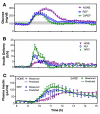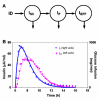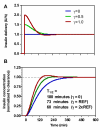Closed-loop insulin delivery utilizing pole placement to compensate for delays in subcutaneous insulin delivery
- PMID: 22226251
- PMCID: PMC3262700
- DOI: 10.1177/193229681100500605
Closed-loop insulin delivery utilizing pole placement to compensate for delays in subcutaneous insulin delivery
Abstract
Background: We have previously used insulin feedback (IFB) as a component of a closed-loop algorithm emulating the β cell. This was based on the observation that insulin secretion is inhibited by insulin concentration. We show here that the effect of IFB is to make a closed-loop system behave as if delays in the insulin pharmacokinetic (PK)/pharmacodynamic (PD) response are reduced. We examine whether the mechanism can be used to compensate for delays in the subcutaneous PK/PD insulin response.
Method: Closed-loop insulin delivery was performed in seven diabetic dogs using a proportional-integral-derivative model of the β cell modified by model-predicted IFB. The level of IFB was set using pole placement. Meal responses were obtained on three occasions: without IFB (NONE), reference IFB (REF), and 2xREF, with experiments performed in random order. The ability of the insulin model to predict insulin concentration was evaluated by correlation with the measured profile and results reported as R(2). The ability of IFB to improve the meal response was evaluated by comparing peak and nadir postprandial glucose and area under the curve (AUC; repeated measures analysis of variance with post hoc test for linear trend).
Results: Insulin concentration was well predicted by the model (median R(2) = 0.87, 0.79, and 0.90 for NONE, REF, and 2xREF, respectively). Peak postprandial glucose (294 ± 15, 243 ± 21, and 247 ± 16 mg/dl) and AUC (518.2 ± 36.13, 353.5 ± 45.04, and 280.3 ± 39.37 mg/dl · min) decreased with increasing IFB (p < .05, linear trend). Nadir glucose was not affected by IFB (76 ± 5.4, 68 ± 7.3, and 72 ± 4.3 mg/dl; p = .63).
Conclusions: Insulin feedback provides an effective mechanism to compensate for delay in the insulin PK/PD profile.
© 2011 Diabetes Technology Society.
Figures




Similar articles
-
Effect of insulin feedback on closed-loop glucose control: a crossover study.J Diabetes Sci Technol. 2012 Sep 1;6(5):1123-30. doi: 10.1177/193229681200600517. J Diabetes Sci Technol. 2012. PMID: 23063039 Free PMC article. Clinical Trial.
-
Identification of intraday metabolic profiles during closed-loop glucose control in individuals with type 1 diabetes.J Diabetes Sci Technol. 2009 Sep 1;3(5):1047-57. doi: 10.1177/193229680900300508. J Diabetes Sci Technol. 2009. PMID: 20144418 Free PMC article.
-
Automated hybrid closed-loop control with a proportional-integral-derivative based system in adolescents and adults with type 1 diabetes: individualizing settings for optimal performance.Pediatr Diabetes. 2017 Aug;18(5):348-355. doi: 10.1111/pedi.12399. Epub 2016 May 18. Pediatr Diabetes. 2017. PMID: 27191182 Clinical Trial.
-
[What is the current state of the artificial pancreas in diabetes care?].Internist (Berl). 2020 Jan;61(1):102-109. doi: 10.1007/s00108-019-00713-y. Internist (Berl). 2020. PMID: 31863132 Review. German.
-
Glucose clamp algorithms and insulin time-action profiles.J Diabetes Sci Technol. 2009 Sep 1;3(5):1005-13. doi: 10.1177/193229680900300503. J Diabetes Sci Technol. 2009. PMID: 20144413 Free PMC article. Review.
Cited by
-
The artificial pancreas: is it important to understand how the β cell controls blood glucose?J Diabetes Sci Technol. 2013 Sep 1;7(5):1359-69. doi: 10.1177/193229681300700528. J Diabetes Sci Technol. 2013. PMID: 24124965 Free PMC article. Review.
-
Use of a food and drug administration-approved type 1 diabetes mellitus simulator to evaluate and optimize a proportional-integral-derivative controller.J Diabetes Sci Technol. 2012 Nov 1;6(6):1401-12. doi: 10.1177/193229681200600621. J Diabetes Sci Technol. 2012. PMID: 23294787 Free PMC article.
-
The effects of inpatient hybrid closed-loop therapy initiated within 1 week of type 1 diabetes diagnosis.Diabetes Technol Ther. 2013 May;15(5):401-8. doi: 10.1089/dia.2013.0002. Epub 2013 Apr 9. Diabetes Technol Ther. 2013. PMID: 23570538 Free PMC article. Clinical Trial.
-
Dietary fat acutely increases glucose concentrations and insulin requirements in patients with type 1 diabetes: implications for carbohydrate-based bolus dose calculation and intensive diabetes management.Diabetes Care. 2013 Apr;36(4):810-6. doi: 10.2337/dc12-0092. Epub 2012 Nov 27. Diabetes Care. 2013. PMID: 23193216 Free PMC article.
-
Effectiveness of early intensive therapy on β-cell preservation in type 1 diabetes.Diabetes Care. 2013 Dec;36(12):4030-5. doi: 10.2337/dc13-1074. Epub 2013 Oct 15. Diabetes Care. 2013. PMID: 24130350 Free PMC article. Clinical Trial.
References
-
- Hovorka R, Allen JM, Elleri D, Chassin LJ, Harris J, Xing D, Kollman C, Hovorka T, Larsen AM, Nodale M, De Palma A, Wilinska ME, Acerini CL, Dunger DB. Manual closed-loop insulin delivery in children and adolescents with type 1 diabetes: a phase 2 randomised crossover trial. Lancet. 2010;375(9716):743–751. - PubMed
-
- Bruttomesso D, Farret A, Costa S, Marescotti MC, Vettore M, Avogaro A, Tiengo A, Dalla Man C, Place J, Facchinetti A, Guerra S, Magni L, De Nicolao G, Cobelli C, Renard E, Maran A. Closed-loop artificial pancreas using subcutaneous glucose sensing and insulin delivery and a model predictive control algorithm: preliminary studies in Padova and Montpellier. J Diabetes Sci Technol. 2009;3(5):1014–1021. - PMC - PubMed
-
- Steil GM, Rebrin K, Darwin C, Hariri F, Saad MF. Feasibility of automating insulin delivery for the treatment of type 1 diabetes. Diabetes. 2006;55(12):3344–3350. - PubMed
Publication types
MeSH terms
Substances
Grants and funding
LinkOut - more resources
Full Text Sources
Other Literature Sources
Medical

